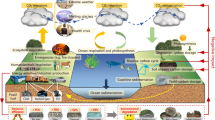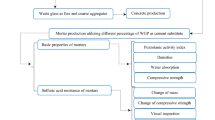Abstract
This article presents a study on the resistance to chloride penetration, corrosion, porosity, and strength of mortar containing fine fly ash (FA), ground rice husk-bark ash (RB), and ground bagasse ash (BA). Ordinary Portland cement (CT) was blended with a single pozzolan and two pozzolans. Strength, porosity, rapid chloride penetration, immersion, and corrosion tests were performed to characterize the mortar. Test results showed that the use of ternary blends of CT, FA, and RB or BA decreased the porosity of the mortar, as compared with binary blended mortar containing CT and RB or BA. The resistance to chloride penetration of the mortar improved substantially with partial replacement of CT with FA, RB, and BA. The use of ternary blends of CT, FA and RB or BA produced the mortar with good strength and resistance to chloride penetration. The resistance to chloride penetration was higher with an increase in the replacement level due to the reduced calcium hydroxide.
Similar content being viewed by others
References
S. Rukzon and P. Chindaprasirt, Strength and carbonation model of rice husk ash cement mortar with different fineness, J. Mater. Civ. Eng., 22(2010), No. 3, p. 253.
P. Chindaprasirt, C. Chotetanorm, and S. Rukzon, Use of palm oil fuel ash to improve chloride and corrosion resistance of high-strength and high-workability concrete, J. Mater. Civ. Eng., 23(2011), p. 499.
S. Rukzon and P. Chindaprasirt, Utilization of bagasse ash in high-strength concrete, Mater. Des., 34(2012), p. 45.
S. Rukzon, P. Chindaprasirt, and R. Mahachai, Effect of grinding on chemical and physical properties of rice husk ash, Int. J. Miner., Metall. Mater., 16(2009), No. 2, p. 242.
S. Rukzon and P. Chindaprasirt, Strength and chloride resistance of blended Portland cement mortar containing palm oil fuel ash and fly ash, Int. J. Miner., Metall. Mater., 16(2009), No. 4, p. 475.
H.Y. Moon., H.S. Kim, and D.H. Choi, Relationship between average pore diameter and chloride diffusivity in various concretes, Constr. Build. Mater., 20(2006), No. 9, p. 725.
ASTM C109, Standard Test Method for Compressive Strength of Hydraulic Cement Mortars (Using 2-in or [50 mm]_Cube Specimens).
ASTM C39, Standard Test Method for Compressive Strength of Cylindrical Concrete Specimens.
ASTM C1202, Standard Test Method for Electrical Indication of Concrete’s Ability to Resist Chloride Ion Penetration.
Test Method RTA T362, Interim Test for Verification of Curing Regime — Sorptivity, Road and Traffic Authority, 2001, p. 3.
N. Otsuki, S. Nagataki, and K. Nakashita, Evaluation of AgNO3 solution spray method for measurement of chloride penetration into hardened cementitious matrix materials, Constr. Build. Mater., 7(1993), No. 4, p.195.
V. Saraswathy and H.W. Song, Corrosion performance of rice husk ash blended concrete, Constr. Build. Mater., 21(2007), No. 8, p. 1779.
P. Chindaprasirt and S. Rukzon, Strength, porosity and corrosion resistance of ternary blend Portland cement, rice husk ash and fly ash mortar, Constr. Build. Mater., 22(2008), No. 8, p. 1601.
A. Sathonsaowaphak, P. Chindaprasirt, and K. Pimraksa, Workability and strength of lignite bottom ash geopolymer mortar, J. Harzad. Mater., 168(2009), No. 1, p. 44.
V. Sata, C. Jaturapitakkul, and K. Kiattikomol, Utilization of palm oil fuel ash in high-strength concrete, J. Mater. Civ. Eng., 16(2004), No. 6, p. 623.
ASTM C618, Standard Test Method for Compressive Strength of Cylindrical Concrete Specimens.
G.C. Isaia, A.L. Gastaldini, and R. Moraes, Physical and pozzolanic action of mineral additions on the mechanical strength of high-performance concrete, Cem. Concr. Compos., 25(2003), No. 1, p. 69.
S. Rukzon and P. Chindaprasirt, Use of disposed waste ash from landfills to replace Portland cement, Waste Manage. Res., 27(2009), No. 6, p. 588.
S. Rukzon and P. Chindaprasirt, Strength and chloride penetration of Portland cement mortar containing palm oil fuel ash and ground river sand, Comput. Concr., 6(2009), No. 5, p. 391.
P. Chindaprasirt., C. Jaturapitakkul, and T. Sinsiri, Effect of fly ash fineness on compressive strength and pore size of blended cement paste, Cem. Concr. Compos., 27(2005), No. 4, p. 425.
M.I. Khan., C.J. Lynsdale, and P. Waldron, Porosity and strength of PFA/SF/OPC ternary blended paste, Cem. Concr. Res., 30(2000), No. 8, p. 1225.
J.M. Khatib and P.S. Mangat, Porosity of cement paste cured at 45°C as a function of location relative to casting position, Cem. Concr. Compos., 25(2003), No. 1, p. 97.
P. Chindaprasirt., S. Rukzon, and V. Sirivivatnanon, Resistance to chloride penetration of blended Portland cement mortar containing palm oil fuel ash, rice husk ash and fly ash, Const. Build. Mater., 22(2008), No. 5, p. 932.
K. Ganesan., K. Rajagopal, and K. Thangavel, Evaluation of bagasse ash as supplementary cementitious material, Cem. Concr. Compos., 29(2007), No. 6, p. 515.
A.M. Neville, Properties of Concrete, 4th Ed., Longman Group UK Limited, Malaysia, 1995.
F.G. Leng, N.Q. Feng, and X.Y. Lu, An experimental study on the properties of resistance to diffusion of chloride ions of fly ash and blast furnace slag concrete, Cem. Concr. Res., 30(2000), No. 6, p. 989.
X. He, Y. Chen, B. Ma, Y. Li, H. Zhang, and W. Zhang, Studies on small ionic diffusivity concrete, [in] Proceedings of the International Workshop on Sustainable Development and Concrete Technology, Beijing, 2004, p. 319.
C.J. Shi and J.A. Stegemann, Acid corrosion resistance of different cementing materials, Cem. Concr. Res., 30(2000), No. 5, p. 803.
M.H. Zhang and V.M. Malhotra, High-performance concrete incorporating rice husk ash as a supplementary cementing material, ACI Mater. J., 93(1996), No. 6, p. 629.
P.K. Mehta, Studies on the mechanisms by which condensed silica fume improves the properties of concrete: durability aspects, [in] Proceedings of International Workshop on Condensed Silica Fume in Concrete, Ottawa, 1987, p. 17.
Author information
Authors and Affiliations
Corresponding author
Rights and permissions
About this article
Cite this article
Rukzon, S., Chindaprasirt, P. Strength, porosity, and chloride resistance of mortar using the combination of two kinds of pozzolanic materials. Int J Miner Metall Mater 20, 808–814 (2013). https://doi.org/10.1007/s12613-013-0800-x
Received:
Revised:
Accepted:
Published:
Issue Date:
DOI: https://doi.org/10.1007/s12613-013-0800-x




